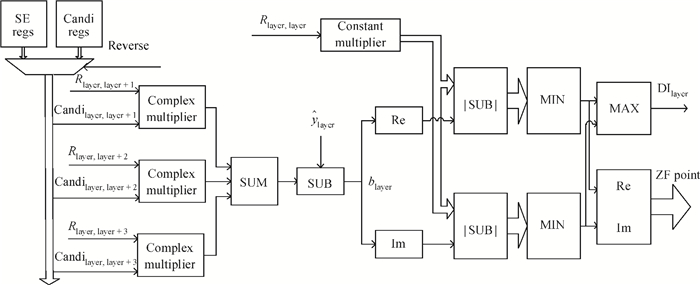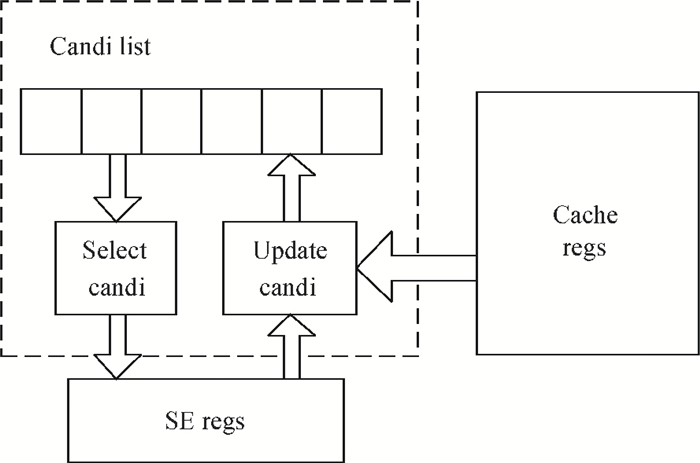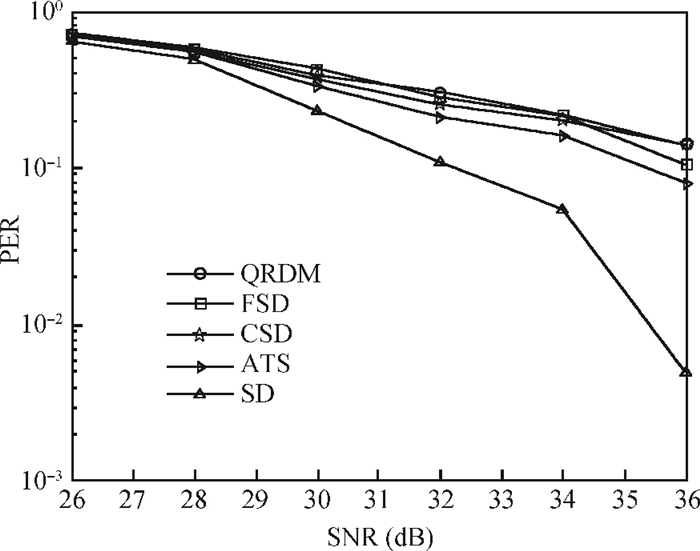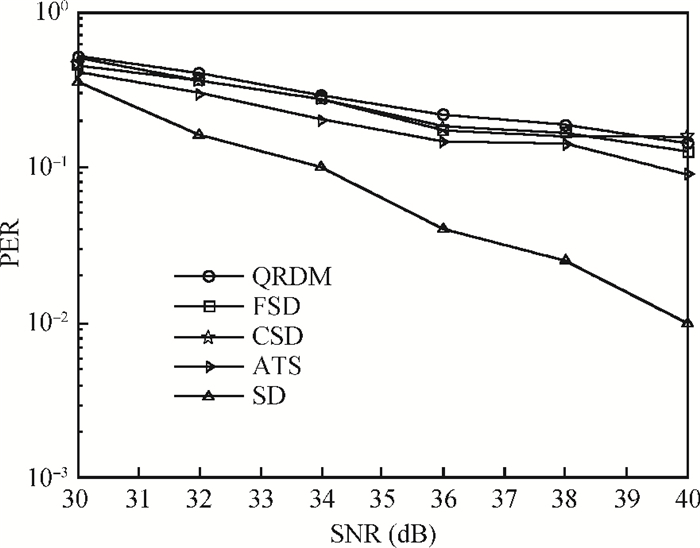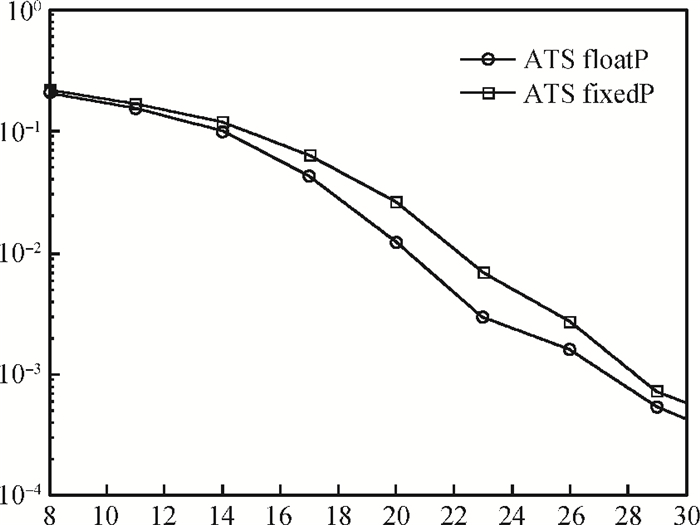| Citation: |
Heng Yao, Haifang Jian, Liguo Zhou, Yin Shi. VLSI implementation of MIMO detection for 802.11n using a novel adaptive tree search algorithm[J]. Journal of Semiconductors, 2013, 34(10): 105005. doi: 10.1088/1674-4926/34/10/105005
****
H Yao, H F Jian, L G Zhou, Y Shi. VLSI implementation of MIMO detection for 802.11n using a novel adaptive tree search algorithm[J]. J. Semicond., 2013, 34(10): 105005. doi: 10.1088/1674-4926/34/10/105005.
|
VLSI implementation of MIMO detection for 802.11n using a novel adaptive tree search algorithm
DOI: 10.1088/1674-4926/34/10/105005
More Information
-
Abstract
A 4×4 64-QAM multiple-input multiple-output (MIMO) detector is presented for the application of an IEEE 802.11n wireless local area network. The detector is the implementation of a novel adaptive tree search (ATS) algorithm, and multiple ATS cores need to be instantiated to achieve the wideband requirement in the 802.11n standard. Both the ATS algorithm and the architectural considerations are explained. The latency of the detector is 0.75 μs, and the detector has a gate count of 848 k with a total of 19 parallel ATS cores. Each ATS core runs at 67 MHz. Measurement results show that compared with the floating-point ATS algorithm, the fixed-point implementation achieves a loss of 0.9 dB at a BER of 10-3. -
References
[1] Foschini G J. Layered space-time architecture for wireless communication in a fading environment when using multi-element antennas. Bell Labs Technical Journal, 1996, 1(2):41 http://ieeexplore.ieee.org/document/6770094/[2] Murugan A, El Gamal H, Damen M, et al. A unified framework for tree search decoding:rediscovering the sequential decoder. IEEE Trans Information Theory, 2006, 52(3):933 doi: 10.1109/TIT.2005.864418[3] Viterbo E, Boutros J. A universal lattice code decoder for fading channels. IEEE Trans Information Theory, 1999, 45(5):1639 doi: 10.1109/18.771234[4] Barbero L G, Thompson J S. Fixing the complexity of the sphere decoder for MIMO detection. IEEE Trans Wireless Commun, 2008, 7(6):2131 doi: 10.1109/TWC.2008.060378[5] Burg A, Borgmann M, Wenk M, et al. VLSI implementation of MIMO detection using the sphere decoding algorithm. IEEE J Solid-State Circuits, 2005, 40(7):1566 doi: 10.1109/JSSC.2005.847505[6] Studer C, Burg A, Bolcskei H. Soft-output sphere decoding:algorithms and VLSI implementation. IEEE J Sel Areas Commun, 2008, 26(2):290 doi: 10.1109/JSAC.2008.080206[7] Guo Z, Nilsson P. Algorithm and implementation of the K-best sphere decoding for MIMO detection. IEEE J Sel Areas Commun, 2006, 24(3):491 doi: 10.1109/JSAC.2005.862402[8] Mahdavi M, Shabany M. Ultra high-throughput architecture for hard-output MIMO detectors in the complex domain. IEEE International Midwest Symposium on Circuits and Systems, Seoul, 2011:1 http://ieeexplore.ieee.org/document/6026425/[9] Shabany M, Gulak P G. A 675 Mbps, 4×464-QAM K-best MIMO detector in 0.13μm CMOS. IEEE Trans Very Large Scale Integration (VLSI) Syst, 2012, 20(1):135 doi: 10.1109/TVLSI.2010.2090367[10] Lin H L, Chang R C, Chan H. A high-speed SDM-MIMO decoder using efficient candidate searching for wireless communication. IEEE Trans Circuits Syst Ⅱ, 2008, 55(3):289 doi: 10.1109/TCSII.2008.918973[11] Yang C Y, Markovic D. A flexible DSP architecture for MIMO sphere decoding. IEEE J Solid-State Circuits, 2009, 56(10):2301 http://ieeexplore.ieee.org/document/4738414/authors[12] Wenk M, Zellweger M, Burg A, et al. K-best MIMO detection VLSI architectures achieving up to 424 Mbps. Proc IEEE Int Symp Circuits Syst, 2006:1151 http://ieeexplore.ieee.org/document/1692794/authors[13] Chen S, Zhang T, Xin Y. Relaxed K-best MIMO signal detector design and VLSI implementation. IEEE Trans Very Large Scale Integration (VLSI) Syst, 2007, 15(3):328 doi: 10.1109/TVLSI.2007.893621[14] Chen S, Zhang T. Low power soft-output signal detector design for wireless MIMO communication systems. Proc Int Symp Low Power Electron Design, 2007:232 http://ieeexplore.ieee.org/document/5514324/[15] Lai K C, Huang C C, Jia J J. Variation of the fixed-complexity sphere decoder. IEEE Commun Lett, 2011, 15(9):1001 doi: 10.1109/LCOMM.2011.072011.110916[16] Lai K, Lin L. Low-complexity adaptive tree search algorithm for MIMO detection. IEEE Trans Wireless Commun, 2009, 8(7):3716 doi: 10.1109/TWC.2009.080902[17] Seethaler D, Bolcskei H. Performance and complexity analysis of infinity-norm sphere-decoding. IEEE Trans Information Theory, 2010, 56(3):1085 doi: 10.1109/TIT.2009.2039034[18] Yao H, Jian H, Shi Y. A new complex sphere detector with SE enumeration. J Electron, 2012, 29(3):190 doi: 10.1007/s11767-012-0786-y?no-access=true[19] Jian Haifang, Shi Yin. A VLSI architecture of K-best detector for MIMO-OFDM wireless communication systems. Journal of Semiconductors, 2009, 30(7):075004 doi: 10.1088/1674-4926/30/7/075004 -
Proportional views





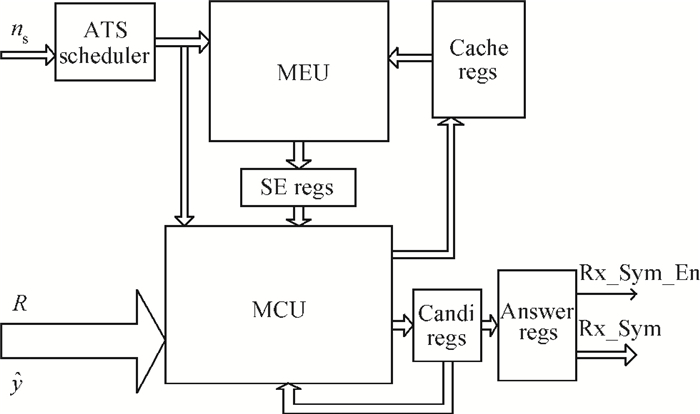
 DownLoad:
DownLoad:
